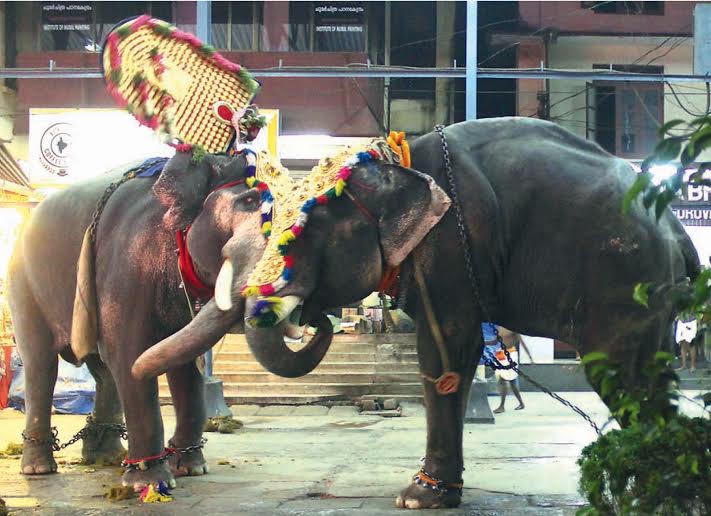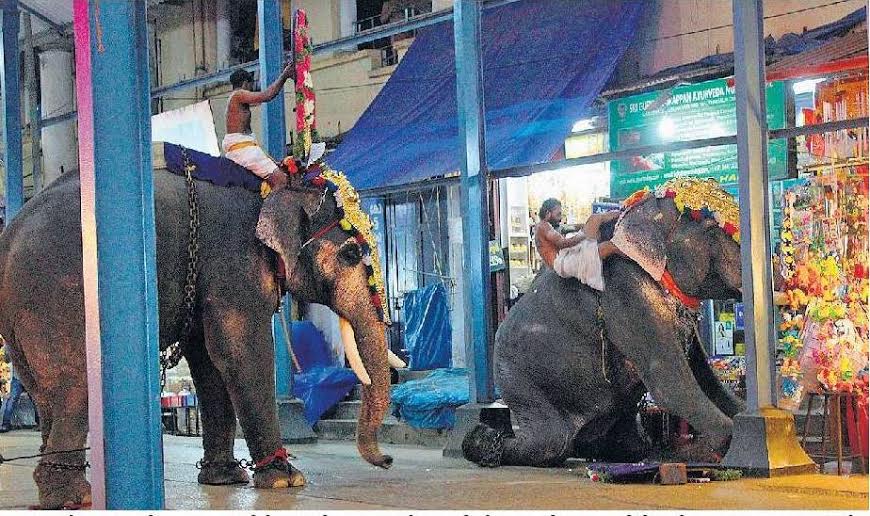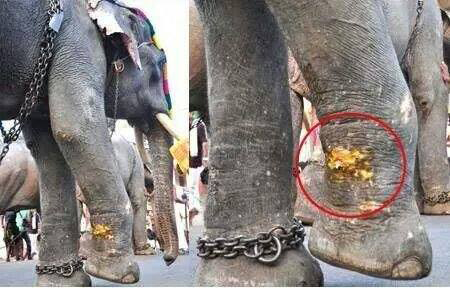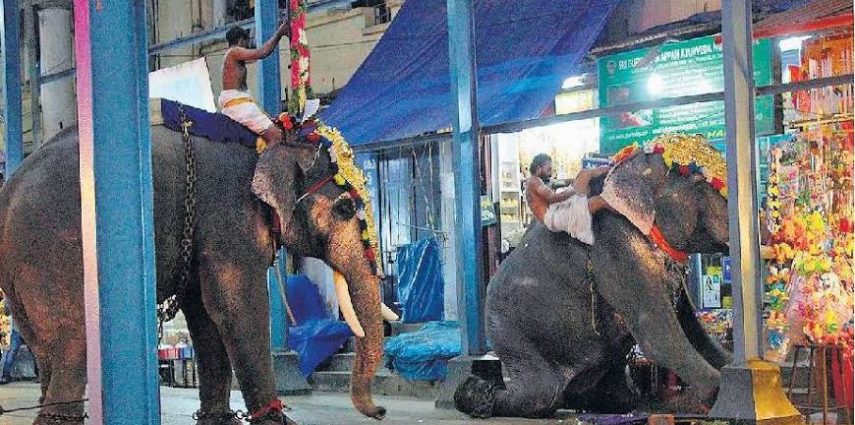
ColognetoCapeTown via Getty Images
Recently a temple in Kerala turned into a battleground after two elephants clashed and literally locked heads, causing panic among the worshipers and inflicting serious injuries to each other.
The elephant that provoked the fight, “Gokul” from Guruvayur Temple, was leased out as the main elephant to carry God’s idol for a parade outside the temple.
According to a complaint filed by Mr. Venkitachalam, Secretary of the Heritage Animal Task Force (HATF), Gokul’s “aggressive behaviour” was triggered by his inability to cope with serious internal injuries in one of the most sensitive areas, after a palm tree collapsed on his body. Unfortunately, he was unable to defend himself from the falling tree, as he was tethered to the ground inside Guruvayur’s elephant camp, with no roof to protect him.
“Even now, the wound inside the tusk of the elephant is causing a high degree of pain and irritation. This Gokul elephant started to attack its co-elephant named ‘Nagerimana Kesavan’ which is originally an elephant brought illegally into Kerala from Bihar six years ago… This is the biggest example of illegal custody and use of Elephants in Kerala for making quick money,” bemoans Venkitachalam.

Apparently, the owner of this elephant who lives near the temple, has not only changed the animal’s name illegally, but also continues to exploit this handicapped elephant, forcing him to limp in the parades. Unable to cope with the pain, he sadly collapsed after he was kicked by “Gokul” on the same injured right foreleg during the fight.

The situation could have been fatal had the elephants attacked the spectators who were dancing and singing at the parade, as these animals cracked, unable to withstand torture and neglect. But then these poor animals would have become the villains and subjected to more torture.
To provide some perspective, a typical work day for festival elephants begins from the time they are precariously loaded into the trucks. In the back of the truck, they’re confined to a tiny area, driven through bumpy roads and chaotic traffic, and deprived of water and food through the long travels. After they reach the destination they are chained in alien environments, decorated with heavy ornaments, forced to parade with strange elephants, and carry unreasonably heavy weights on their back in the intense heat and humidity.
No matter how well-behaved, the elephants are constantly poked and prodded by the mahouts with goads, ‘ankush’ or bull hooks and chains to control them. Meanwhile the insane crowd dances to the deafening music, oblivious to the pain and suffering of these sentient beings.
Perhaps it may be easier to comprehend (although not condone) why these gentle giants are exploited in the name of culture and religion when you consider the significant revenue these elephants generate for Guruvayur Temple. It’s also easier to understand, why the Guruvayur Devaswom Board (GDB) encourages the hiring and use of their elephants, and disregards stern warnings against such practices by the Central Government of India.
The Animal Welfare Board of India (AWBI) — a government body — recently launched an investigation against the world renowned Guruvayur Temple, after receiving numerous complains from local activists and the media, and has released a scathing report “The Report on the Welfare & Veterinary Status of Captive Elephants at Punnathur Kotta, Guruvayur Devaswom Board.”
The report says, between January 2014 and April 2014 — a total of 120 festival days — 38 out of the 59 elephants were leased out. In the four month span, a 52-year-old elephant Gopikrishnan worked for 77 days, i.e. more than 64 per cent of the festival days.
Celebrity elephants, like Padmanabhan, were made to toil continuously for 18-20 hours, and according to the AWBI report they “earn up to seven lakhs for a day’s work. Padmanabhan was put to work for a period of 55 days, reflecting that he spent more than 45 per cent of these four months working, at 74 years of age.”
A daily wage of seven Lakh Indian rupees is a whopping USD$116,600 — and this is just a fraction of the profits that the Guruvayur Devaswom Board generates to run a religious business that willfully ignores the pain and suffering of a senior elephant.
The amount of revenue generated annually by the festival elephants alone totalled up to Rs.3,71,50,000.00, (Rs.3.7 crores), close to USD$670,000. And the overall 2014-2015 revenue including donations by devotees, sponsorship(s) and Gurvayur Temple’s Punathoor Kotta elephant camp is estimated to reach seven crores, approximately USD$1.1 million.
Clearly there’s more to the use of elephants in temples and festivals than people in Kerala would like to believe, or want the world to know. The AWBI report says,
“Cultural practices cannot be considered greater than the laws of the land, whereby the exploitation of India’s Heritage animal is condoned. For the Guruvayur Devaswom Board owned elephants, this is indeed a great sacrilege. It is well known that the elephant ‘culture’ has less to do with religion and more to do with commerce and trade.”

In another temple this wounded elephant, Shivasankaran was made to limp and parade from one festival ground to another. I’ve been informed that, despite several complaints, Kerala’s forest officials are yet to provide medical care for this poor animal.
These elephants are leased out like cars, but even mechanical vehicles tend to break down when they run out of gas. Additionally, proper maintenance is required for the car to function properly. Now, it doesn’t take a rocket scientist to understand that these conscious sentient beings that respond to their natural instincts need and deserve much more care and compassion.
The injustice against these animals is reprehensible. Despite the enormous revenues they earn for GDB, the elephants are deprived of their most basic necessities — inadequate food, water, bath and rest. All they care about is stuffing their pockets, as the mesmerized masses of Kerala follow the so called “cultural festivals” blindly.
Clearly, elephants’ welfare is subjugated to the appointment schedules of festival parades for commercial return. No surprise, they are battling it out with each other and running amok! Why are people in Kerala surprised that the elephants are “behaving aggressively”?
This damning conclusion after the historic AWBI investigation should be a wake-up call to the wealthy and status-quo that exploit and torture elephants in the name of culture and religion.
“No institution, however prestigious and powerful, can hope to insulate itself when it is on the wrong side of public opinion on a long-standing humane concern. In just a few short years, the Guruvayur Devaswom’s elephant keeping model has lost its shine, seen its value downgraded, mishandled tragic incidents involving the brutal assault on the captive elephants and its reputation is being affected by swelling public skepticism of its elephant facility.”

